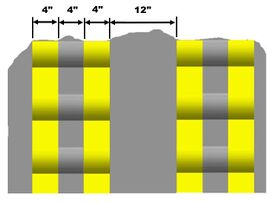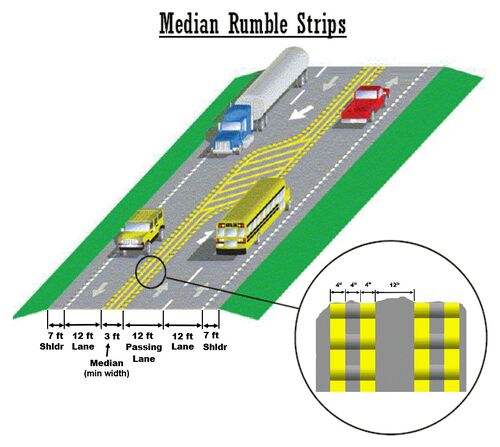626.2 Centerline Rumble Strips

All two-lane major roads with new pavement will have centerline rumble strips (see figure at right) unless the posted speed is less than 50 mph. Centerline rumble strips are provided on all major two-lane roads, and on minor roads with a cross-centerline crash history. Rumble strips on a centerline have been shown to reduce head-on crashes by alerting drivers that they are leaving their lane of travel. On roadways with a travelway width of 20 ft. or less, centerline rumble strips become obtrusive and are not recommended.

As with edgeline rumble strips, pavement marking material is sprayed over the centerline rumble strip, creating what is often called a “rumble stripe.”
Rumble strips in the median of typical passing lane roadways (see Std. Plan 626.00 Rumble Strips) vary somewhat from centerline rumble strips on typical two-lane roadways (see figure, to the left). Passing lanes can operate effectively with no separation between opposing lanes of travel. While no separation is required, AASHTO guidance recommends that some separation, however small, between the lanes in opposite directions of travel is desirable. Therefore, a flush median separation of a minimum of 3 ft. between the opposing directions of travel is required on new passing lane roadways retrofitted on existing alignment and a minimum median separation width of 4 feet on any passing lane roadway constructed on new alignment (See Std. Plan 620.00 for pavement marking details and Std. Plan 626.00 for rumble strip details).

In order to maintain the integrity of the rumble strip and the pavement, the pavement material must be either concrete or the final lift of bituminous material must be least 1 inch thick. Centerline rumble strips are not to be placed on bridges or within the limits of an intersection with left turn lanes. The limits of the intersection are defined by the beginning of the tapers for the left turn lanes. The length of centerline rumble strip installation should be estimated and pay items provided.